Extract from Arizona Highways Magazine, March 2006, reproduced with permission.

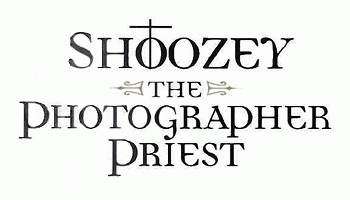
Shoozey the Photographer Priest
By Vickey Kalambakal
Father Augustine Schwarz hoped to serve as a missionary in 1916 to a war-convulsed world, but instead the earnest young priest found himself dispatched to the remote Indian communities of southern Arizona, where a keen eye and a Brownie camera made him a witness to an intimate history and a culture in the throes of change. The Franciscan priest used his little Kodak Brownie to snap photos of chapels, schools and celebrations which he sent back to his five brothers and sisters in Chicago, thereby preserving history in black and white.
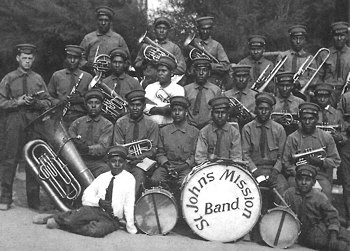
Mission Band
Students of the St.John's Indian School on the Gila Indian Reservation formed the St.John's Mission Band, photographed by Father Schwarz in 1921.
He worked first with the Pima Indians at St.John's Mission and Boarding School in Komatke, along the Gila River south-west of Phoenix. He taught the 500 students and struggled to build up his congregation in the face of competition from Protestant missionaries. He visited settlements like Fort McDowell, Wetcamp, Florence and Sacaton Flats, where he met with people living in windowless huts next to chicken coops.
Soon after his arrival, he traveled 30 miles to St.Francis of Assisi Church on the Salt River and photographed a procession carrying huge arches festooned with paper flowers, and preparations for a dinner of freshly slaughtered chicken and beef. He photographed students, like Thomas Jose, his wagon driver and the coronet player at St.John's Indian School.
With all of his traveling, the other priests and brothers began calling Father Schwarz "Shoozey" - a name that stuck. Years later, Shoozey told his nieces that he traveled first by mule, then by horse-drawn wagon and finally in an old touring car.
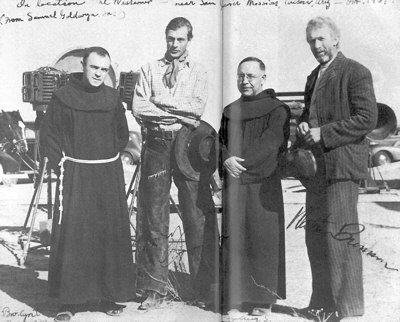
Movie Set
Father Augustine "Shoozey" Schwarz, third from the left, on the set of the 1949 film The Westerner, with stars Gary Cooper, second from left, and Walter Brennan, a.k.a. Judge Roy Bean, right, near Mission San Xavier del Bac in Tuscon.
After three years at St.John's, Shoozey was transferred to the San Solano Mission on the Papago (now called Tohono O'odham) Reservation southwest of Tucson. He photographed the Yaqui matachini dancers during the three-day long fiesta honoring St.Francis Xavier, patron of the centuries-old Mission San Xavier del Bac.
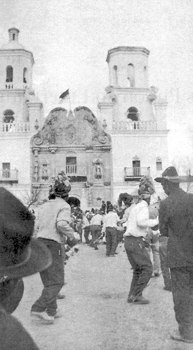
Celebratory Dance
A group of Yaqui Indians, photographed by Shoozey in front of Mission San Xavier del Bac, perform what he called "a religious dance" in celebration of the Feast of Saint Francis Xavier on December 3, 1919.
At San Solano, Shoozey oversaw the completion of St.Joseph's Chapel in Pisinimo, and at the dedication he photographed dozens of children standing before the front doors.
The following year he helped build a church in Cowlic, west of Pisinimo, with $3,000 donated by a group of lay Franciscans in Cleveland, and equipped it with a chalice imported from Germany and an altar and three paintings by artist Vladimir Shamburg from Chicago. The bishop of Tucson attended the dedication of the tiny, 15-foot-wide church.
In addition, the Franciscan fathers also opened day schools for Indian children throughout the Southwest. While previous generations of Indian children had been forced to leave their families and forsake their language at boarding schools, these small day schools did not separate children from their parents or their traditions and language. In 1922, Shoozey returned to St.John's Indian School, having learned enough of the native language that he no longer needed interpreters. He spent six months chaperoning the school band members on a fund-raising tour of the eastern United States.
Next he went to the Fort Apache Reservation, where he spent several years working with the students at Theodore Roosevelt Boarding School. At nearby Whiteriver, he photographed the Apache Indians' Mountain Spirit Dance, wickiup huts and the small Catholic church. Here, his younger brother, Arnold, also a Franciscan priest and an amateur photographer, joined him. The brothers drove around the reservation in an old Ford Father Arnold had acquired, a definite improvement over mules and wagons.
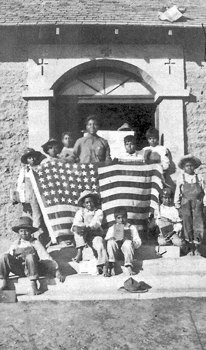
Patriotic Pose
Students from the Anegam Day School on the Tohono O'odham nation pose with an American flag in front of St.Clare Church in 1920.
In 1927, Shoozey returned to the Pima (Tohono, O'odham) Indian Reservation as the superior of the San Solano Mission in Topowa, and its recently completed stone church to which Shoozey immediately added a Nativity scene with money he had inherited. He returned to the Apache reservation for one more short stint, before going back finally to the Tohono O'odham where he celebrated his 25th anniversary as a priest by dedicating an adobe church he helped to build. Before dedicating St.Paul the Apostle in Chiawuli Tak, Shoozey drove all the way to Chicago and back to pick up a donated neo-Gothic marble altar.
When World War II broke out, Shoozey was transferred to Yuma as a chaplain for German and Italian prisoners of war, probably due to his fluent German. From there, he moved to California where his health faltered. He suffered a heart attack in 1946 and was treated and released from a Los Angeles hospital. But on April 25, 1946, his fellow priests found him on floor of his room at 3 A.M., his rosary clasped firmly in his hands.
In Chicago his family held onto his photographs until niece Elizabeth Jones in 1986 donated them to Arizona State University, where Labriola National American Indian Data Center curator Patricia Etter maintains them. Many of Shoozey's pictures are now part of an online exhibit at www.asu.edu/lib/archives/schwarz. Enhancing the presentation are photographs showing the churches today-some in ruins, some still an active part of the community. AH
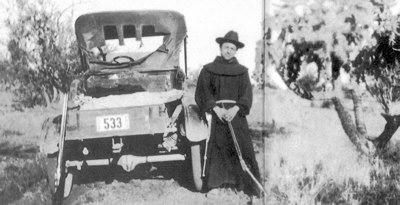
Poor Padre
Father Schwarz poses with his old Ford truck near San Solano. When ordained, Franciscan priests take a vow of poverty.
About the Author
Vickey Kolombakal of Claremont, California, learned of Father Schwarz's photographs when she worked in the Labriolo center as a graduate student at Arizona State University.
|

